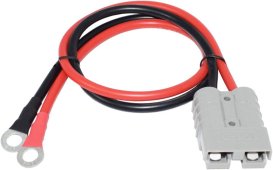My off grid and grid tied systems are separate except for the AC input to the off grid system to change the batteries and pass through the current to a critical loads panel. The off grid system is basically a partial home UPS system
I have 6 of the Signature Solar EG4-LL batteries in the 6 slot rack. There are times when there is not enough current to pass through to the critical loads panel to supply loads and charge the batteries at the same time. In a timely manner anyway.
I would like to utilize the EG4 18amp charger at these times. The charger can be hooked up by clipping the alligator clips to the battery rack bus bars and plugging it in. With the rack being full and the bus bars having heat shrink in places the battery cables don't attached to it, this is a difficult and not very timely way to do it. I am looking for a simpler method.
Would this be safe?
Attaching something like this to the one empty space of the positive & negative bus bars, then swapping out the alligator clips on the charger for the appropriate matching connectors? Might not be an Anderson type connector like this, but could be power pole or xt 90 type connectors or similar.

Any feedback would be greatly appreciated.
I have 6 of the Signature Solar EG4-LL batteries in the 6 slot rack. There are times when there is not enough current to pass through to the critical loads panel to supply loads and charge the batteries at the same time. In a timely manner anyway.
I would like to utilize the EG4 18amp charger at these times. The charger can be hooked up by clipping the alligator clips to the battery rack bus bars and plugging it in. With the rack being full and the bus bars having heat shrink in places the battery cables don't attached to it, this is a difficult and not very timely way to do it. I am looking for a simpler method.
Would this be safe?
Attaching something like this to the one empty space of the positive & negative bus bars, then swapping out the alligator clips on the charger for the appropriate matching connectors? Might not be an Anderson type connector like this, but could be power pole or xt 90 type connectors or similar.

Any feedback would be greatly appreciated.
Last edited:


